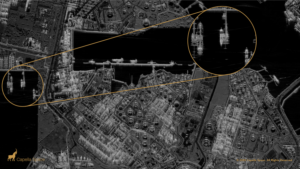16 showcase the Spotlight mode of Sequoia, a 100-kilgram radar satellite designed to dwell over a location for 20 to 60 seconds.
“We have found 20 centimeters is our sweet spot, but its customizable,” Payam Banazadeh, Capella Space CEO and founder, told SpaceNews.
Since it was founded in San Francisco in 2017, Capella Space has been working to establish a constellation of SAR satellites to provide daily global imagery and data to government and commercial customers. Capella Space launched Sequoia, its first operational satellite, in August on a Rocket Lab Electron rocket.
In marketing materials, Capella Space compares Sequoia’s performance with that of competitors.
“No one else can do the 50-centimeter square pixels natively,” Banazadeh said.
It’s difficult to compare SAR imagery, though, because marketing materials often cite resolution in a single dimension rather than range and azimuth. In addition, engineers are designing SAR satellites to stare at locations to gather multiple images that can be displayed in a series to highlight movement or combined to produce sharper images.
Competition is fierce among SAR startups jockeying for position in the growing market for imagery that reveals what is happening on the ground day, night and through clouds. There is already strong demand among government agencies for SAR data and the emerging commercial market is expected to eventually eclipse government demand.
Current U.S. remote sensing regulations make it easier to sell unenhanced data that is “substantially the same as unenhanced data available from sources not regulated by” the U.S. Commerce Department, according to the National Oceanic and Atmospheric Administration rule published in May.
For now, Banazadeh says that rule means the more stringent regulations apply to the sale of SAR imagery with a resolution better than 50 centimeters by 50 centimeters.
“As regulations catch up to technologies we will be upgrading and releasing even higher resolution imagery down to 25 centimeters,” Banazadeh said. “All of these breakthroughs, innovations and milestones will ultimately help our U.S. government, commercial and international ally customers make critical, high-impact and potentially life-saving decisions.”
While waiting to launch Sequoia, Capella focused on developing the constellation infrastructure including automated satellite tasking through Inmarsat geostationary satellites, cloud-based data processing and data delivery through an API or the company’s web application.
All those elements are working well, Banazadeh said.



